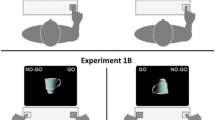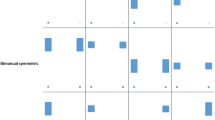Abstract
People often grasp objects with an awkward grip to ensure a comfortable hand posture at the end of the movement. This end-state comfort effect is a predominant constraint during unimanual movements. However, during bimanual movements the tendency for both hands to satisfy end-state comfort is affected by factors such as end-orientation congruency and task context. Although bimanual end-state comfort has been examined when the hands manipulate two independent objects, no research has examined end-state comfort when the hands are required to manipulate two physically-coupled objects. In the present experiment, kinematics and grasp behavior during a unimanual and bimanual reaching and placing tasks were examined, when the hands manipulate two physically-connected objects. Forty-five participants were assigned to one of three groups; unimanual, bimanual no-spring (the objects were not physically connected), and bimanual spring (the objects were connected by a spring), and instructed to grasp and place objects in various end-orientations, depending on condition. Physically connecting the objects did not affect end-state comfort prevalence. However, it resulted in decreased interlimb coupling. This finding supports the notion of a flexible constraint hierarchy, in which action goals guide the selection of lower level action features (i.e., hand grip used for grasping), and the particular movements used to accomplish that goal (i.e., interlimb coupling) are controlled throughout the movement.



Similar content being viewed by others
Notes
In no trials were there any gaps greater than this.
Analysis revealed no significant differences between egocentric and allocentric congruency, (χ 2(1) = 0.024, P = 0.878), thus the data were collapsed across congruency.
The comfort ratings were assessed using a separate pool of participants (n = 20, X = 24.79, SD = 3.21, 6 males and 14 females). A repeated measures ANOVA was conducted on the factors Initial grip (overhand, underhand), Hand (left hand, right hand), and Object end-orientation (0° rotation, 90° internal rotation, 180° rotation, 90° external rotation). Analysis revealed significant main effects of Initial grip [F(1,18) = 5.15, P = 0.04] and Object end orientation [F(1,18) = 5.15, P = 0.04], but not Hand [F(1,18) = 0.16, P = 0.70]. There was also a significant Initial grip × Object end-orientation interaction [F(3,54) = 39.57, P = 0.01]. Post hoc analyses revealed that mean comfort ratings were higher for the overhand grip compared to the underhand grip when no rotation [t(18) = 4.47, P < 0.01] and 90° external rotation [t(18) = 15.93, P < 0.01] was required. In contrast, when the movement required either 90° internal rotation or 180° rotation, participants rated underhand grips more comfortable than overhand grips [t(18) = −11.90, P < 0.01 and t(18) = −7.02, P < 0.01, respectively].
As with the grip data, we did not observe differences between egocentric and allocentric congruency for any of the timing and kinematic variables. Therefore, the egocentric and allocentric data were compressed to form the identical end-orientation condition.
References
Abbs JH, Gracco VL, Cole KJ (1984) Control of multimovement coordination: sensorimotor mechanisms in speech motor programming. J Mot Behav 16:195–232
Bootsma RJ, Marteniuk RG, Mackenzie CL, Zaal FTJM (1994) The speed-accuracy trade-off in manual prehension: effects of movement amplitude, object size and object width on kinematic characteristics. Exp Brain Res 98:535–541
Chieffi S, Gentilucci M (1993) Coordination between the transport and the grasp components during prehension movements. Exp Brain Res 94:471–477
Claxton LJ, Keen R, McCarty ME (2003) Evidence of motor planning in infant reaching behavior. Psychol Sci 14:354–356
Easton TA (1972) On the normal use of reflexes. Am Sci 60:591–599
Fischman MG, Stodden DF, Lehman DM (2003) The end-state comfort effect in bimanual grip selection. Res Q Exerc Sport 74:17–24
Franz EA (2003) Bimanual action representation: a window to human evolution. In: Johnston-Frey S (ed) Taking action: cognitive neuroscience perspectives on the problem of intentional acts. MIT Press, Cambridge, pp 259–288
Franz EA, McCormick R (2010) Conceptual unifying constraints override sensorimotor interference during anticipatory control of bimanual actions. Exp Brain Res 203:273–282
Franz EA, Zelaznik HN, McCabe G (1991) Spatial topological constraints in a bimanual task. Acta Psychol 77:137–151
Franz EA, Eliassen J, Ivry RB, Gazzaniga MS (1996) Dissociation of spatial and temporal coupling in the bimanual movements of callosotomy patients. Psychol Sci 7:306–310
Franz EA, Zelaznik HN, Swinnen SP, Walter CW (2001) Spatial conceptual influences on the coordination of bimanual actions: when a dual task becomes a single task. J Mot Behav 33:103–112
Hughes CML, Franz EA (2008) Goal-related planning constraints in bimanual grasping and placing of objects. Exp Brain Res 188:541–550
Janssen L, Beuting M, Meulenbroek RGJ, Steenbergen B (2009) Combined effects of planning and execution constraints on bimanual task performance. Exp Brain Res 192:61–73
Janssen L, Crajé C, Weigelt M, Steenbergen B (2010) Motor planning in bimanual object manipulation: two plans for two hands? Mot Control 14:240–254
Janssen L, Meulenbroek RGJ, Steenbergen B (2011) Behavioral evidence for left-hemisphere specialization of motor planning. Exp Brain Res 209:65–72
Jeannerod M (1984) The timing of natural prehension movements. J Mot Behav 16:235–254
Kelso JAS (1984) Phase transitions and critical behavior in human bimanual coordination. Am J Physiol Regul Integr Comp Physiol 18:645–668
Kelso JAS, Southard DL, Goodman D (1979) Coordination of 2-handed movements. J Exp Psychol Hum Percept Perform 5:229–238
Kelso JAS, Tuller B, Vatikiotis-Bateson E, Fowler CA (1984) Functionally specific articulatory cooperation following jaw perturbations during speech: evidence for coordinative structures. J Exp Psychol Hum Percept Perform 10:812–832
Kunde W, Weigelt M (2005) Goal congruency in bimanual object manipulation. J Exp Psychol Hum Percept Perform 31:145–156
Kunde W, Krauss H, Weigelt M (2009) Goal congruency without stimulus congruency in bimanual coordination. Psychol Res 73:34–42
Ma S, Feldman AG (1995) Two functionally different synergies during arm reaching movements involving the trunk. J Neurophysiol 73:2120–2122
Marteniuk RG, MacKenzie CL, Jeannerod M, Athenes S, Dugas C (1987) Constraints on human arm movement trajectories. Can J Psychol 41:365–378
Mechsner F, Kerzel D, Knoblich G, Prinz W (2001) Perceptual basis of bimanual coordination. Nature 414:69–73
Rosenbaum DA, Marchak F, Barnes HJ, Vaughan J, Slotta JD, Jorgensen MJ (1990) Constraints for action selection: overhand versus underhand grips. In: Jeannerod M (ed) Attention and performance XIII. Motor representation and control. Lawrence Erlbaum, Hillsdale, pp 211–265
Rosenbaum DA, Vaughan J, Jorgensen MJ, Barnes HJ, Stewart E (1993) Plans for object manipulation. In: Meyer DE, Kornblum S (eds) Attention and performance XIV: synergies in experimental psychology, artificial intelligence, and cognitive neuroscience. MIT Press, Cambridge, pp 803–820
Rosenbaum DA, van Heugten CM, Caldwell GE (1996) From cognition to biomechanics and back: the end-state comfort effect and the middle-is-faster effect. Acta Psychol 94:59–85
Shaiman S (1989) Kinematic and electromyographic responses to perturbation of the jaw. J Acoust Soc of Am 86:78–88
Short MW, Cauraugh JH (1999) Precision hypothesis and the endstate comfort effect. Acta Psychol 100:243–252
Turvey MT (1979) The thesis of efference-mediation of vision cannot be rationalized. Behav Brain Sci 2:81–83
Turvey MT (1991) Coordination. Am Psychol 45:938–953
Van der Wel R, Rosenbaum DA (2010) Bimanual grasping planning reflects changing rather than fixed constraint dominance. Exp Brain Res 205:351–362
Weigelt M (2007) Re-examining structural constraints on the initiation of bimanual movements: the role of starting locations, movement amplitude, and target locations. Hum Mov Sci 26:212–225
Weigelt M, Kunde W, Prinz W (2006) End-state comfort in bimanual object manipulation. Exp Psychol 53:143–148
Weigelt M, Rieger M, Mechsner F, Prinz W (2007) Target-related coupling in bimanual coupling in bimanual reaching movements. Psychol Res 71:438–447
Weir P, MacKenzie CL, Marteniuk RG, Cargoe SL, Frazer MB (1991) The effects of object weight on the kinematics of prehension. J Mot Behav 23:192–204
Author information
Authors and Affiliations
Corresponding author
Rights and permissions
About this article
Cite this article
Hughes, C.M.L., Haddad, J.M., Franz, E.A. et al. Physically coupling two objects in a bimanual task alters kinematics but not end-state comfort. Exp Brain Res 211, 219–229 (2011). https://doi.org/10.1007/s00221-011-2673-4
Received:
Accepted:
Published:
Issue Date:
DOI: https://doi.org/10.1007/s00221-011-2673-4




